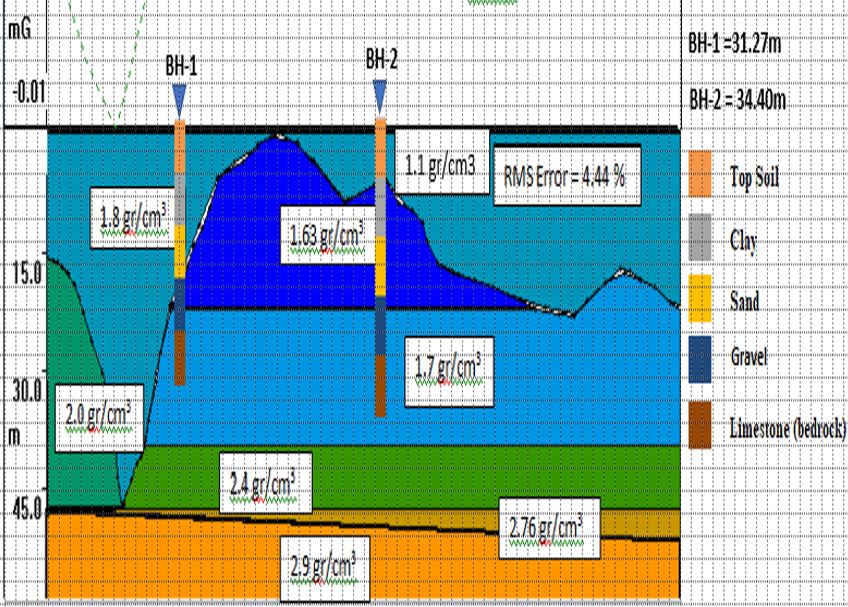Assessment of Microgravity Anomalies of Soil Structure for Geotechnical 2D Models
DOI:
https://doi.org/10.24273/jgeet.2018.3.3.2058Keywords:
Microgravity, Anomaly, Density contrast, ModellingAbstract
A microgravity investigation on bedrock topography was conducted at Maluri Park in Kuala Lumpur, Malaysia. The study characterized the subsurface structure to delineate soil structure for the geotechnical application. Cross-section modelling of the residual anomaly generated the Maluri Bouguer Anomaly model for test site. The 2D microgravity models produced the contour map, displaying the characterization due to density contrast in rock types while mapping the subsurface geological structure at different depths. Moreover, a synthetic model was initiated with the assumption of lateral distance on the left and right sides taken at 50 m and a depth of 60 m. The results of modeling confirmed that the soil and rock type composition on models test site, i.e: topsoil (1.1 g/cm3), soil (1.8 g/cm3), clay (1.63 g/cm3), gravel (2.0 g/cm3), sand (1.7 g/cm3), shale (2.40 g/cm3), sandstone (2.76 g/cm3) and limestone (2.9 g/cm3). The 2D gravity synthetic model show a good match with the observed microgravity data.
Downloads
References
Ebbing, J., Braitenberg, C., Götze, H.-J., 2001. Forward and inverse modelling of gravity revealing insight into crustal structures of the Eastern Alps. Tectonophysics 337, 191–208. doi:10.1016/s0040-1951(01)00119-6
Kamal, H., Taha, M, and Al-Sanad, S.,2010. Environmental Engineering and Geotechnics, GeoShanghai 2010 International Conference. (accessed 02.03.17)
Kearey, P., Brooks, M., Hill, I., 2011. An introduction to geophysical exploration. Blackwell Publishing, Malden, MA.
Lillie, R.J., 1999. Whole earth geophysics: an introductory textbook for geologists and geophysicists. Prentice Hall, Upper Saddle River, NJ. https://nla.gov.au/anbd.bib-an13624882
Pringle, J.K., Styles, P., Howell, C.P., Branston, M.W., Furner, R., Toon, S.M., 2012. Long-term time-lapse microgravity and geotechnical monitoring of relict salt mines, Marston, Cheshire, U. K. Geophysics 77. https://doi.org/10.1190/geo2011-0491.1
Samsudin, Hj., T., 2003. A microgravity survey over deep limesone bedrock, Geological Society of Malaysia, Bulletin 46, pp 201-208 (accessed 12.11.16). http://archives.datapages.com/ data/ geological-society-of-malaysia/bulletins/ 046/ 046001/ pdfs/ 201.htm
Tan, S., M. ,2005. Karstic Features of Kuala Lumpur Limestone. Bulletin of the Institution of Enginner Malaysia, June 2005, 6 -11. (accessed 08.02.17)
Tajuddin, A. and Lat, C. N., 2004. Detecting subsurface voids using the microgravity method-A case study from Kuala Lipis, Pahang, Geological Society of Malaysia, Bulletin 48, p. 31 – 35. (accessed 11.01.16) http://archives.datapages.com/data/geological-society-of-malaysia/bulletins/ 048/ 048001/ pdfs/ 31.htm
Telford, W.M., Geldart, L.P., Sheriff, R.E., 2010. Applied geophysics. Cambridge Univ. Press, Cambridge.
Talwani, M., Ewing, M., 1960. Rapid Computation of Gravitational Attraction of Three‐Dimensional Bodies of Arbitrary Shape. Geophysics 25, 203–225. https://doi.org/10.1190/1.1438687

Downloads
Published
Issue
Section
License
Copyright @2019. This is an open-access article distributed under the terms of the Creative Commons Attribution-ShareAlike 4.0 International License which permits unrestricted use, distribution, and reproduction in any medium. Copyrights of all materials published in JGEET are freely available without charge to users or / institution. Users are allowed to read, download, copy, distribute, search, or link to full-text articles in this journal without asking by giving appropriate credit, provide a link to the license, and indicate if changes were made. All of the remix, transform, or build upon the material must distribute the contributions under the same license as the original.










